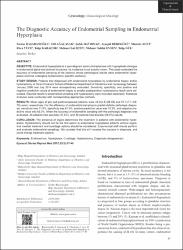| dc.contributor.author | Başaranoğlu, Serdar | |
| dc.contributor.author | Ağaçayak, Elif | |
| dc.contributor.author | Hatırnaz, Şafak | |
| dc.contributor.author | Deregözü, Ayşegül | |
| dc.contributor.author | Acet, Mustafa | |
| dc.contributor.author | Yüce, Ebru | |
| dc.contributor.author | Karaçor, Talip | |
| dc.contributor.author | İçen, Mehmet Sait | |
| dc.contributor.author | Evsen, Mehmet Sıddık | |
| dc.contributor.author | Gül, Talip | |
| dc.date.accessioned | 2022-04-13T10:30:52Z | |
| dc.date.available | 2022-04-13T10:30:52Z | |
| dc.date.issued | 2017 | en_US |
| dc.identifier.citation | Başaranoğlu, S., Ağaçayak, E., Hatırnaz, Ş., Deregözü, A., Acet, M., Yüce, E. ... Gül, T. (2017). The diagnostic accuracy of endometrial sampling in endometrial hyperplasia. Gynecology Obstetrics & Reproductive Medicine, 23(1), 37-40. | en_US |
| dc.identifier.issn | 1300-4751 | |
| dc.identifier.issn | 2602-4918 | |
| dc.identifier.uri | http://doi.org/10.201613/GORM.2016.635 | |
| dc.identifier.uri | https://hdl.handle.net/20.500.12511/9328 | |
| dc.description.abstract | OBJECTIVE: Endometrial hyperplasia is a premalignant lesion characterized with hyperplastic changes in endometrial gland and stromal structures. Its incidence is not exactly known. This study evaluated the accuracy of endometrial sampling of the patients whose pathological results were endometrial hyperplasia and had undergone hysterectomy (paraffin sections). STUDY DESIGN: Patients that diagnosed with endometrial hyperplasia by endometrial biopsy and/or hysterectomy at Dicle University School of Medicine Department of Obstetrics and Gynecology between January 2006 and July 2014 were retrospectively evaluated. Sensitivity, specificity, and positive and negative predictive values of endometrial biopsy to predict postoperative hysterectomy result were calculated. Discrete results in endometrial sampling and hysterectomy were recorded separately. Statistical analyses were conducted with corresponding appropriate methods. RESULTS: Mean ages of pre and postmenopausal patients were 42.6±4.8 (28-50) and 57.7±7.7 (50- 79) years, respectively. For the efficiency of endometrial sampling to predict definite pathologic diagnosis, sensitivity was 71.9%, specificity was 87.5%, positive predictive value was 79.3%, and negative predictive value was 82.3%. When the accuracy of endometrial sampling with the pathologic diagnosis was evaluated, 38 patients had accurate (47.5%), and 42 patients had discrete (52.5%) results. CONCLUSION: The presence of atypia determines the treatment in patients with endometrial hyperplasia. Hysterectomy should not be the first option in endometrial hyperplasia patients without atypia, and medical treatment and curettage options should be considered. Experienced staff should perform and evaluate endometrial samplings. We consider that this will increase the success in diagnosis, and could change treatment options. | en_US |
| dc.language.iso | eng | en_US |
| dc.publisher | Medical Network | en_US |
| dc.rights | info:eu-repo/semantics/openAccess | en_US |
| dc.subject | Endometrium | en_US |
| dc.subject | Hyperplasia | en_US |
| dc.subject | Curettage | en_US |
| dc.subject | Hysterectomy | en_US |
| dc.subject | Diagnostic Disagreement | en_US |
| dc.title | The diagnostic accuracy of endometrial sampling in endometrial hyperplasia | en_US |
| dc.type | article | en_US |
| dc.relation.ispartof | Gynecology Obstetrics & Reproductive Medicine | en_US |
| dc.department | İstanbul Medipol Üniversitesi, Tıp Fakültesi, Cerrahi Tıp Bilimleri Bölümü, Kadın Hastalıkları ve Doğum Ana Bilim Dalı | en_US |
| dc.identifier.volume | 23 | en_US |
| dc.identifier.issue | 1 | en_US |
| dc.identifier.startpage | 37 | en_US |
| dc.identifier.endpage | 40 | en_US |
| dc.relation.publicationcategory | Makale - Ulusal Hakemli Dergi - Kurum Öğretim Elemanı | en_US |
| dc.identifier.doi | 10.201613/GORM.2016.635 | en_US |
| dc.institutionauthor | Acet, Mustafa | |
| dc.identifier.trdizinid | TWpReU1EQTJOZz09 | en_US |


















